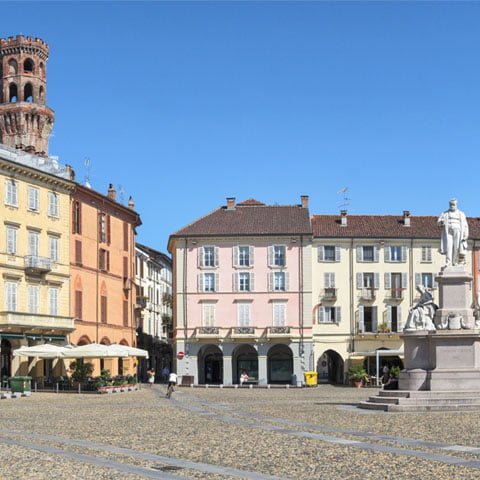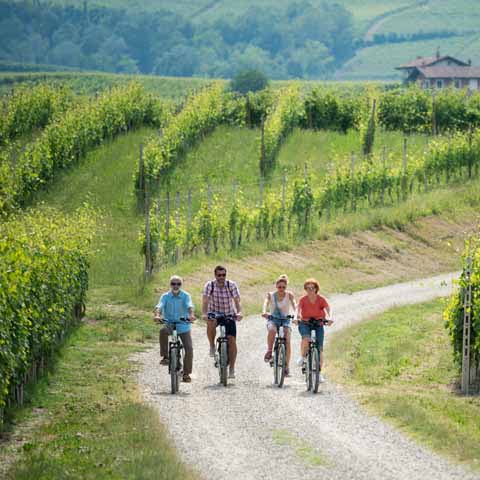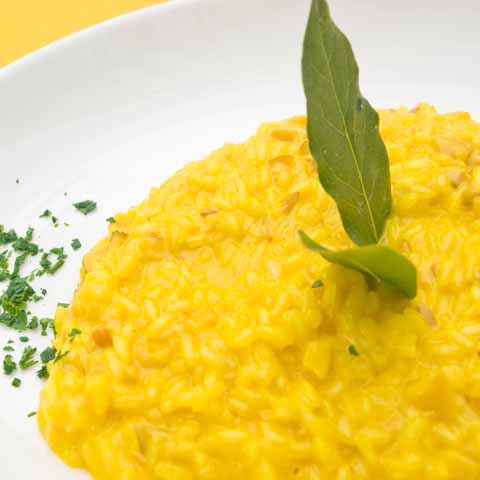Vercelli is located in the Piedmont region of Northern Italy, between Milan and Turin. Visiting Vercelli means taking a dip in its history. As a result of its location in the fertile Po Valley, Vercelli thrived during the Roman Imperial Age with an economy based on agriculture. After the fall of Rome, Vercelli experienced a decline until administration of the city was taken over by bishops.
Today, Vercelli is best known for its rice fields and the beauty of the surrounding natural landscapes. But Vercelli is not only nature and landscapes; thanks to its history, Vercelli has plenty to offer also from a cultural point of view, making the city a pleasant surprise for those visiting Piedmont. The city is easy to explore on foot since most museums, churches, and palaces are located around the center of the town. The historic center is lively and elegant with fascinating ancient buildings that follow one another in the streets between museums and churches full of treasures.
Vercelli does not only house treasures and artistic masterpieces. The local gastronomy is simple, yet tasty. Food and wine lovers cannot be disappointed here. Among the dishes not to be missed are the panissa, a typical dish based on rice and beans, salame della duja, pork rind, the Bicciolani biscuits, and of course, the full-bodied red wines produced in the nearby lands that are recognized among the best wines of Italy for their delicacy and harmony.
FESTIVALS AND EVENTS
One of best-known events in Vercelli is the Processione delle Macchine, or the Procession of the Machines. This event takes place every year on Good Friday. It is an evocative religious rite, dating back to the second half of the seventeenth century, when Bishop Broglia instituted the procession. The “machines” are large sculptures in colored wood, which depict the Stations of the Cross and are kept in the churches of Vercelli during the year. During the procession, the locals carry the statues on their shoulders through the streets of the city. The machines depict Jesus in the garden of the olive trees, Jesus at the column, the coronation of thorns, the flagellation, Ecce Homo, Our Lady of Sorrows, and the crucifixion. This last machine is kept in the Cathedral.
Another event that attracts visitors takes place in Caresana, approximately 9 miles south of Vercelli. The village is famous for its traditional oxen race that is held each spring on April 23 in honor of the patron saint, San Giorgio. Documents attest that the race was held for the first time 770 years ago, while the feast originated from a religious vow expressed by the population for the end of the plague. At midday, pairs of oxen, yoked on four-wheeled wagons decorated for the occasion, compete in a wild race for the conquest of a flag with the image of St. George. After the race, the flag is displayed on the rudder of the victorious cart. Besides the race, cultural events, music, and other live entertainment performances are organized for the occasion.
Every year, in early September, the Palio del Col a dell’Oca (which translates to Goose Neck Palio) takes place in the village of Fontanetto Po. It is an evocative competition, in which four knights, one for each district of the village, participate. The contenders must tear, proceeding at a gallop, the neck of a wooden puppet, in the shape of a goose that hangs from a rope, make three turns on a circular path, and deposit the trophy in a basket. In addition to the competition, there is a historical parade with allegorical floats that takes place through the streets of the town featuring knights of the districts, flag-wavers, and representatives of neighboring villages wearing eighteenth-century costumes.
Rosario Fiorito or Flowered Rosary is a devotional procession in traditional costumes widespread among the Walser, the population of German origins that settled at the foot of Monte Rosa centuries ago and left traces of their traditions both in religion and art. This procession was born from the custom of going to pray the rosary on the Sesia glacier, under Monte Rosa, for the souls who wandered there in the form of butterflies. Flowers are thrown during the procession that takes place in October in Alagna Valsesia, a small village high in the Valsesia alpine valley in the province of Vercelli. It is not difficult to find processions similar to the Rosario Fiorito during the summer in the province of Vercelli, above all in the mountain villages.
Among the manifestations of folklore, the Carnival is of particular importance in the province of Vercelli. Among the most important carnivals, in addition to that of Vercelli and Varallo, there are the Borgosesia Carnival which ends with the characteristic Mercù Scurot and the Historic Carnival of Santhià, the oldest in Piedmont.
OUTDOOR
The province of Vercelli presents three different kinds of landscapes in just a few miles: the mountains of Valsesia with Monte Rosa, the hills covered by vineyards, and the plain, dominated by the rice paddy fields. These three landscapes are the result of man’s precise way of engaging with the territory, inevitably conditioned by climatic, morphological, and territorial aspects.
For lovers of outdoor life, Vercelli offers various paths that, on foot or by bicycle, lead along the rice roads and allow visitors to discover fascinating panoramas. Rich in architecture, landscape, and ingenious hydraulic works, the rice fields offer breathtaking views in every season.
For those who love walking, it is possible to walk along a stretch of the Via Francigena. Vercelli is an important stage on this journey of faith on the pilgrimage to Rome.
The Vercelli rice-growing landscape is marked by a dense maze of canals, bridges, and extraordinary hydraulic engineering works that bring water to the rice fields. The landscape is dotted with farmhouses, small villages, and woods. Visitors can meet the Po River, the largest Italian river with its 405 miles of length, which separates two different environments: on one side the green hills of Monferrato and on the other the water of the Vercelli rice fields.
The Po River Park includes several protected natural areas. The site is particularly interesting for birdwatchers. An important agricultural center on the border of the Vercelli province, Fontanetto Po is known for being the birthplace of Giovanni Battista Viotti, one of the greatest musicians of the eighteenth century. The village preserves one of the jewels of Romanesque-Gothic architecture of the province of Vercelli, the Church of San Sebastiano.
Also very interesting is the bell tower of the Church of San Martino constructed in Norman Romanesque style that measures more than 180 feet tall. Not far away is an ancient mill (the San Giovanni mill), which is the only remaining testimony of a rice mill operated by the motive power in the Province of Vercelli.
At the Abbey of Lucedio, now a farm, travelers can find traces of medieval architecture, the ancient boundary wall, and the church with a unique octagonal bell tower with a square base.
The Church of the Santissimo Nome di Maria, better known as the Sanctuary of the Madonna delle Vigne, dates back to the first half of the seventeenth century and was constructed in Piedmontese Baroque style. According to legend, an interior fresco preserves a song known as the “Devil’s Score” that when played backwards is said to release a demon held inside the Abbey of Lucedio.
Strolling through Vercelli’s streets, the medieval towers cannot go unnoticed. Vercelli is in fact the only turreted city in Piedmont. One example is Torre dell’Angelo, which overlooks the central Piazza Cavour. The square has always been the economic and beating heart of the city and it was likely the seat of the ancient Roman Forum. Completely surrounded by arcades, the square owes its name to the monument that stands in the center dedicated to Count Camillo Benso di Cavour.
Numerous beautiful noble palaces embellish the city of Vercelli. Worthy of note are Palazzo De Rege Thesauro, which has a completely decorated terracotta façade; Palazzo Avogadro della Motta, where Napoleon was hosted twice; and Palazzo Buronzo d’Asigliano, a splendid Neoclassical example.
INDOOR
Vercelli is considered to be the “European capital of rice”, but it is actually much more than this. Surely, the city is one of Piedmont’s richest in cultural treasures and artistic masterpieces. As such, Vercelli is filled with a number of interesting museums and churches.
The city’s most popular museum is the Francesco Borgogna Museum. The Brogogna Museum is housed in an elegant Neoclassical building on three floors, where 800 works are exhibited. They include furniture, decorative arts, paintings, and graphic sculptures, dating back to a period from the fifteenth to the twentieth centuries. Antonio Borgogna (1822-1906), founder of the Museum, lawyer and benefactor from Vercelli, dedicated his life to collecting and to numerous trips to Europe, the Middle East and North Africa, setting up a rich museum house. Worthy of mention are the altarpieces and the Piedmontese Renaissance frescoes, the canvas by Angelo Morbelli, the monumental canvases by Giuseppe Cominetti on the theme of work, and the portraits of Ambrogio Alciati.
ARCA is an exhibition center that was built in 2007 inside the former Church of San Marco. The church was originally erected in 1266 then deconsecrated by Napoleon and subsequently transformed into a public market. The central nave is made of glass and steel. From the glass vaults of the Arca, visitors can admire the impressive medieval vaults of the Church of San Marco where marvelous fifteenth century frescoes were recently brought to light.
Another interesting museum in Vercelli is the MAC: Civic Archaeological Museum of Vercelli. Situated in the old Santa Chiara Monastery, it is named after the Barnabite father Luigi Bruzza, an illustrious scholar who dedicated himself to the history and archeology of Vercelli. The museum offers an archaeological collection consisting of over six hundred finds and illustrates the history of ancient Vercellae. The path is organized in chronological order in seven thematic rooms.
Leone Museum was created at the beginning of the twentieth century thanks to the bequest of the collection of the Vercelli notary Camillo Leone. The museum is housed in two historic buildings: Casa Alciati and the eighteenth-century Palazzo Langosco, joined together by a connecting building designed in 1939 in which the archaeological section is set up. The museum displays Roman finds from the area, including a famous bilingual Latin-Gallic stele, collections of decorative art with majolica and glass from major Italian factories, gold, furniture, and eighteenth-century clothes. The Leone Museum also features an ancient library that hosts about 20,000 volumes. The splendid Sala delle Armi exhibits swords, daggers, armor, helmets, and much more from the Middle Ages to the nineteenth century. The rooms of the museum are dedicated to popular goldsmiths of the area. Here, ornaments for hairstyles, bracelets, necklaces, rings and other refined jewels are on display.
Vercelli is also home to two other curious museums: the Pharmacy Museum and the Metric Museum. The Pharmacy Museum tells the evolution of the pharmacy over two hundred years of history. The collection exhibits more than 2,000 objects including sling bars, spirit aerosols, mortars, marble pestles of all sizes, stills, vases and others. It is home to incredible curiosities such as the large crocodile hanging from the vault of the ceiling of the laboratory room.
The Metric Museum at the headquarters of the Chamber of Commerce collects and exhibits the ancient measuring instruments belonging to the Metric Office of the Chamber of Commerce These objects include scales, meters, containers for measuring liquids and more.
Among the Churches, one of the symbols of the city for more than 800 years is without any doubt the Abbey of Sant’Andrea. It was built in the early thirteenth century by the will of Cardinal Guala Bicchieri. The church is an excellent example of the fusion of Romanesque and Gothic elements with a Latin Cross plan. The façade is in a majestic green color and features a large splendid rose window. The interior is sober with three naves, cross vaults, and columns.
The imposing Duomo of Sant’Eusebio is the city Cathedral and another symbol and distinctive feature of the city. It was probably built as a cemetery basilica by Eusebio himself, the first proto-bishop of Vercelli and rebuilt several times over the centuries. The eighteenth-century baroque façade is surmounted by the large dome, built in the nineteenth century, and the medieval bell tower. Inside, suspended in the center of the main nave, there is a splendid crucifix in silver foil from the Ottonian era, considered one of the most important examples of sacred art of the Middle Ages.
The Museo del Tesoro del Duomo (Cathedral Treasure Museum) located in the Archbishop’s Palace, preserves one of the richest existing collections of sacred objects. Furnishings, reliquaries and artifacts of inestimable value and splendid workmanship are displayed here. In the rooms there are goldsmith works from the seventh to the seventeenth centuries, the anastatic copy of the Vercelli Book, which is the famous late tenth century codex in the ancient Anglo-Saxon language as well as finds resulting from the restoration of the great Ottonian Crucifix of the Cathedral, reliquaries, and liturgical furnishings.
The Church of San Cristoforo is a small-town jewel that houses some precious works by the artist Gaudenzio Ferrari. The church, also known as the Sistine Chapel of Vercelli, is completely frescoed and preserves some of the most important masterpieces of the Piedmontese Renaissance, such as the altarpiece of the Madonna degli Aranci, the Stories of Mary Magdalene, the Stories of the Virgin Mary, the Crucifixion, and the Assumption of the Virgin.
The Synagogue in the center of the historic Jewish ghetto was inaugurated in 1878. It is among the largest synagogues in Italy and a significant example of Moorish-style architecture. The construction of the Synagogue, furnishings, and all religious objects were donated by the Jews of the city. In addition to the main prayer hall, the building includes two women’s galleries, the balcony, and side rooms used as a historical archive and museum.
FAMILIES AND KIDS
Many paths in Valsesia and in the area around Vercelli are suitable for children. The natural parks offer activities and routes for all tastes.
Castles are always fascinating for children of any age as well as for parents, and the Vercelli area is rich in these buildings. In some cases, the castles are noble residences, while others had a defensive aim.
The Albano Vercellese Castle is one of the most impressive. Sources still testify to the presence of a 40-foot-wide moat in the seventeenth century. A tower of the ancient structure is still visible.
The Castle of Balocco originated in the twelfth century, but was destroyed and rebuilt several times over the centuries, the last time starting from the beginning of the fifteenth century, where a quadrangular plan with four towers on the sides was chosen. Today a quadrangular building remains with the ruins of the entrance tower and two other towers to the north.
The Castle of Buronzo, in an optimal position for strategic control over the surrounding area, had a military function until the seventeenth century. According to historians, other castles, such as that of Casanova Elvo, were used to preserve the products of the harvest. The quadrangular building with a large internal courtyard and a fifteenth-century entrance tower remain.
The Castle of Lenta is a rare example of a fortified monastery, in fact the Benedictine female monastery of San Pietro resided inside it until 1572. The castle still has an imposing aspect that refers to its original function as a center of defense and power. The numerous remaining frescoes testify to the latter.
The Castle of Montonero was a rural manor of which there is evidence starting from the fourteenth century that, under the Cistercian monks, it became a center of agricultural management, including reception and shelter for tools, men, animals and agricultural products.
The Castle of Quinto Vercellesi has an interesting drawbridge and moat, both of which are still visible. A drawbridge and moat are also visible at the Castle of Villata, where a cylindrical tower on which a bell has been placed rises from the fifteenth-century tower.
UNIQUE EXPERIENCES
The so-called Valsesian supervolcano, in the heart of the western Alps, was active 290 million years ago. Its important and notable eruptions led to a sinking with a diameter of several miles. After 10 million years of activity, however, the volcano went into a phase of inactivity until it collapsed on itself. When Africa and Europe collided about 60 million years ago, the Alps formed. But at the Valsesia, the turning of the earth’s crust brought out the deepest parts of the volcano’s feeding system. As a result, the entire magmatic apparatus that once stood under the volcano, at a depth of about 15 miles, has emerged. It is a unique case in the world and thanks to its geological peculiarity it is part of the UNESCO Global Geoparks.
From stunning natural beauty to a wealth of archeology, architecture, and art, Vercelli offers plenty of interesting activities to its visitors. When planning a trip to the Piedmont region of Northern Italy, travelers would be remiss to not consider a stop in Vercelli.
Don't just see Italy, live it.
Your dream trip to Italy has never been closer
No more endlessly scrolling travel sites. Our travel experts will craft the perfect, one-of-a-kind trip just for you.

300+
DESTINATIONS
We offer more Italian destinations than any travel site. Do and see more with Trips 2 Italy.
1 (of a kind)
ITINERARIES
Because your dream trip to Italy should be designed for you, not for the masses.
100%
PEACE OF MIND
From flights and accommodations, to food and activities - we take care of every detail.







